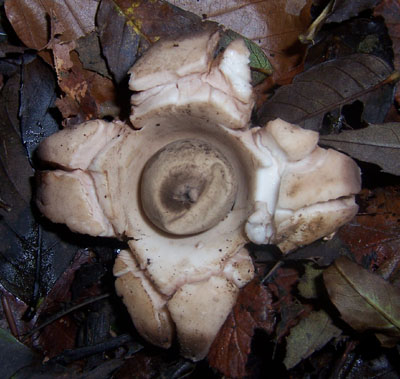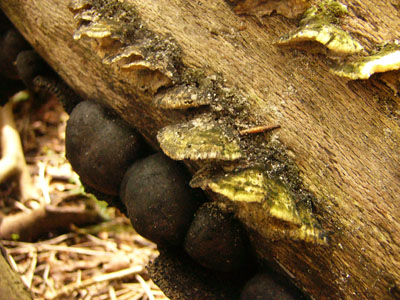Fungi Fanatics

Summer may well be coming to an end, but as the nights draw in, the temperatures drop, the long rains set in and the leaves start to fall, the woodlands take on a new lease of life. As any of the legions of fungi fanatics will tell you, a forage around the forests in Autumn can be as exhilarating as a safari across the Serengeti. You don’t have to eat what you find, and in most cases you would be exceedingly ill-advised to do so. Just take your camera and a spotters guide, and watch a whole new world open up before your very eyes. Shelley Evans and Geoffrey Kibby’s Pocket Nature: Fungi is the best of the pocket guides on the market, but the more zealous mycologist will certainly want to keep a copy of Roger Phillips’ encyclopaedic, though rather less-portable, Mushrooms of Great Britain and Europe on their shelves back at home.
 What we think of as mushrooms, or toadstools if we’re talking about the non-edible variety, are in fact only the fruiting bodies of a much larger organism. Like icebergs, the bulk remains hidden from view in a great underground cobweb of colourless, near-invisible, hair-like filaments called hyphae. These feed on organic material such as leaf litter and weave themselves under the bark of fallen trees, turning dead plant matter into soil. Each fungus possesses a dense, intertwining network of hyphae called the mycelium. The largest organism on this planet is an individual Honey Fungus (Armillaria mellea) in America whose mycelial mat covers a staggering 2,200 acres of land, though its fruits are only 6 - 15cm high.
What we think of as mushrooms, or toadstools if we’re talking about the non-edible variety, are in fact only the fruiting bodies of a much larger organism. Like icebergs, the bulk remains hidden from view in a great underground cobweb of colourless, near-invisible, hair-like filaments called hyphae. These feed on organic material such as leaf litter and weave themselves under the bark of fallen trees, turning dead plant matter into soil. Each fungus possesses a dense, intertwining network of hyphae called the mycelium. The largest organism on this planet is an individual Honey Fungus (Armillaria mellea) in America whose mycelial mat covers a staggering 2,200 acres of land, though its fruits are only 6 - 15cm high.
Mushrooms and toadstools, which can appear and disappear within a matter of days, sometimes hours, have enchanted people since ancient times. Just think of the Fly Agaric (Amanita muscaria) whose lurid red cap flecked with white dots has long been associated with folklore, fairy tales and witchery. Back in the 1970s the Biblical scholar John Allegro caused a scandal with his book The Sacred Mushroom and the Holy Cross when he suggested that the New Testament was a cover story to disguise Christianity’s roots in ancient cults that used the mushroom in religious rituals; in short, that Christ was in fact a mushroom. Now what would Dan Brown make of that? You’d be exceedingly foolish to contemplate the Fly Agaric as a path to spiritual enlightenment, however. As Allegro himself acknowledged, its consumption leads to vomiting, diarrhoea, muscular convulsions, hot flushes and in many cases, death.
Just a handful of toadstools will kill you, but it is worth remembering that most don’t necessarily signal their toxicity as flagrantly as the red-for-danger cap of the Fly Agaric. The aptly-named species of Destroying Angel (Amanita virosa), Poison Pie (Hebeloma crustuliniforme) and Death Cap (Amanita phalloides) all look pretty nondescript, but they’ll finish you off in a matter of hours, and beware, just because a mushroom is not toxic to slugs, it doesn’t mean it won’t be toxic to humans!
The vast majority of the 4000 species found across the British Isles are not fatal, but this doesn’t mean they’re edible either. Many are too small, too hard or too vile-tasting. Cardboard or tree bark would be preferable to chewing on Cramp Balls (Daldinia concentrica), Dead Man’s Fingers (Xylaria polymorpha), Dung Roundheads (Stropharia semiglobata) or Dog Stinkhorns (Mutinus caninus). Also, different people react differently to different species, and the long-terms effects of consuming most are still unknown. Some, like the Common Inkcap (Coprinus atramentarius), react incredibly badly with alcohol, even several days after it has entered the bloodstream.
Of course, as anyone who has tasted fresh Chanterelles (Cantharellus cibarius) or Ceps (Boletus edulis) fried in butter and garlic will testify, some are absolutely delicious. But the golden rule is to assume the worst. If you’re not an expert and you can’t be 100% sure you have identified your bounty correctly, you’re better off just looking, not touching. Those interested in finding out which are good to eat are advised to join one of the many fungi foraging groups that have sprung up across the country over recent years.
 Many people are just content with taking photographs, or the challenge of identifying the ephemeral fruits of these fascinating organisms. Many are quite beautiful, and come in a plethora of colours, shapes, and sizes, as these pictures of the Yellow Staghorn (Calocera viscosa) and Magpie Inkcap (Coprinus picaceus) demonstrate. Some are just plain bizarre, like the Collared Earthstar (Geastrum triplex) or Jelly Ear (Auricularia auricula-judae), the latter used extensively in Asian cuisine.
Many people are just content with taking photographs, or the challenge of identifying the ephemeral fruits of these fascinating organisms. Many are quite beautiful, and come in a plethora of colours, shapes, and sizes, as these pictures of the Yellow Staghorn (Calocera viscosa) and Magpie Inkcap (Coprinus picaceus) demonstrate. Some are just plain bizarre, like the Collared Earthstar (Geastrum triplex) or Jelly Ear (Auricularia auricula-judae), the latter used extensively in Asian cuisine.
Its amazing that, even today, so little is known about these intriguing organisms that are closer to the animal kingdom than the plant kingdom, but recent research is proving that fungi possess all manner of important qualities that can enhance not only one’s personal well-being, but benefit the environment too. To find out more about mushrooms that have been used for anything from clearing up oil pollution to a clean and effective way of ridding houses of insect infestations, I recommend Paul Stamets’ inspiring book Mycelium Running: How Mushrooms Can Help Save the World.
Comments are closed for this post.
Discussion
There are several websites where you can post photos and ask for help identifying mushrooms – unfortunately I only know the Norwegian ones but perhaps the woodlands.co.uk blog can do a follow-up post next autumn :)
The small woodland owners group (www.swog.org.uk) has a fungi ID walk coming up in East Sussex. Email me if you are interested in knowing more
tracy@woodlands.co.uk
It’s a very exciting time of year. Hubby and friend have just gone off to the new forest to forage for ceps, chanterelles, trompetes and hedgehogs so that we can have a big risotto cook up at the end of September in our fire woks. What could be a better way to bring in the Autumn?

Please note, that the mushroom walk was last year and we don’t have one planned for this year
thanks
Tracy
Tracy
20 September, 2010